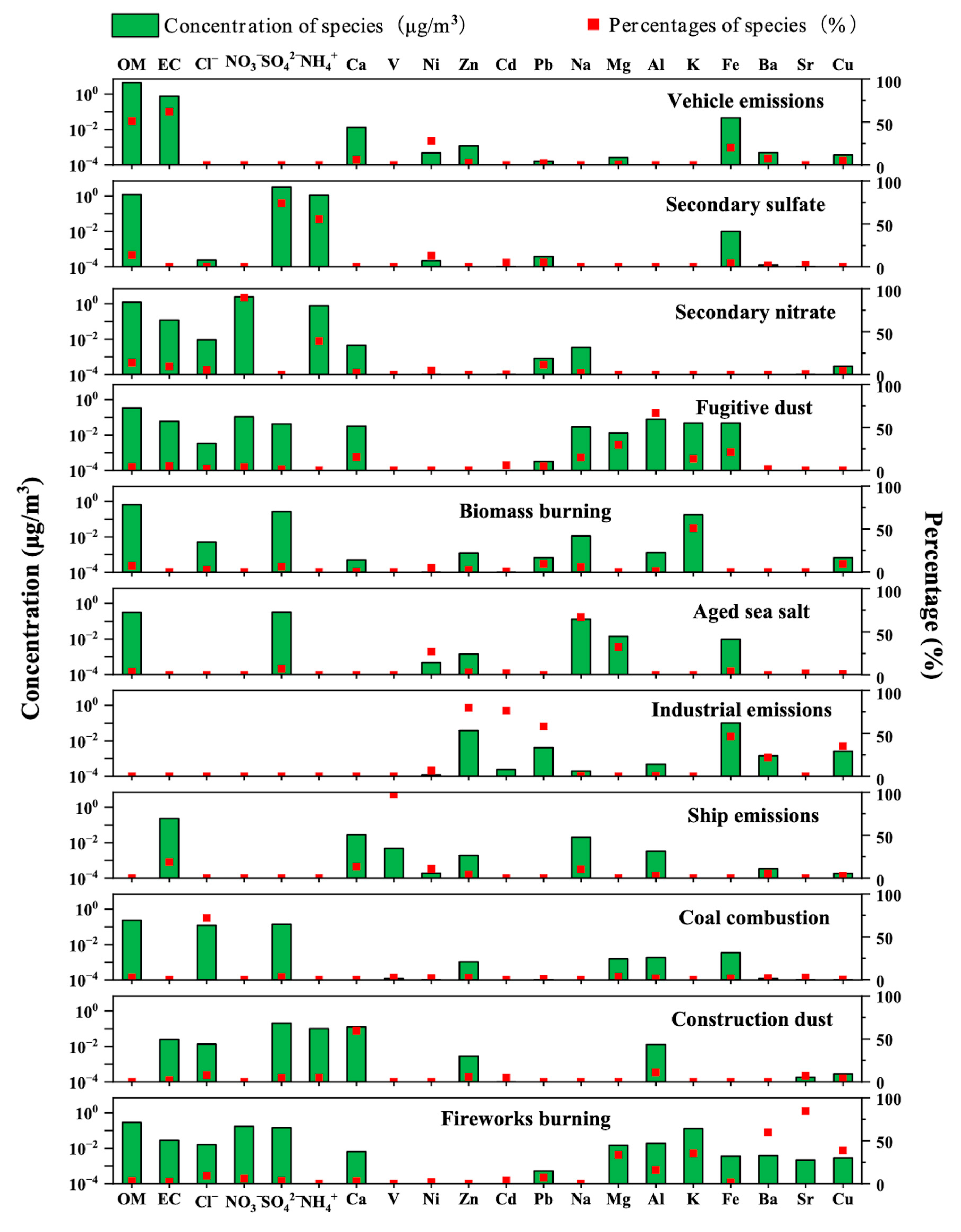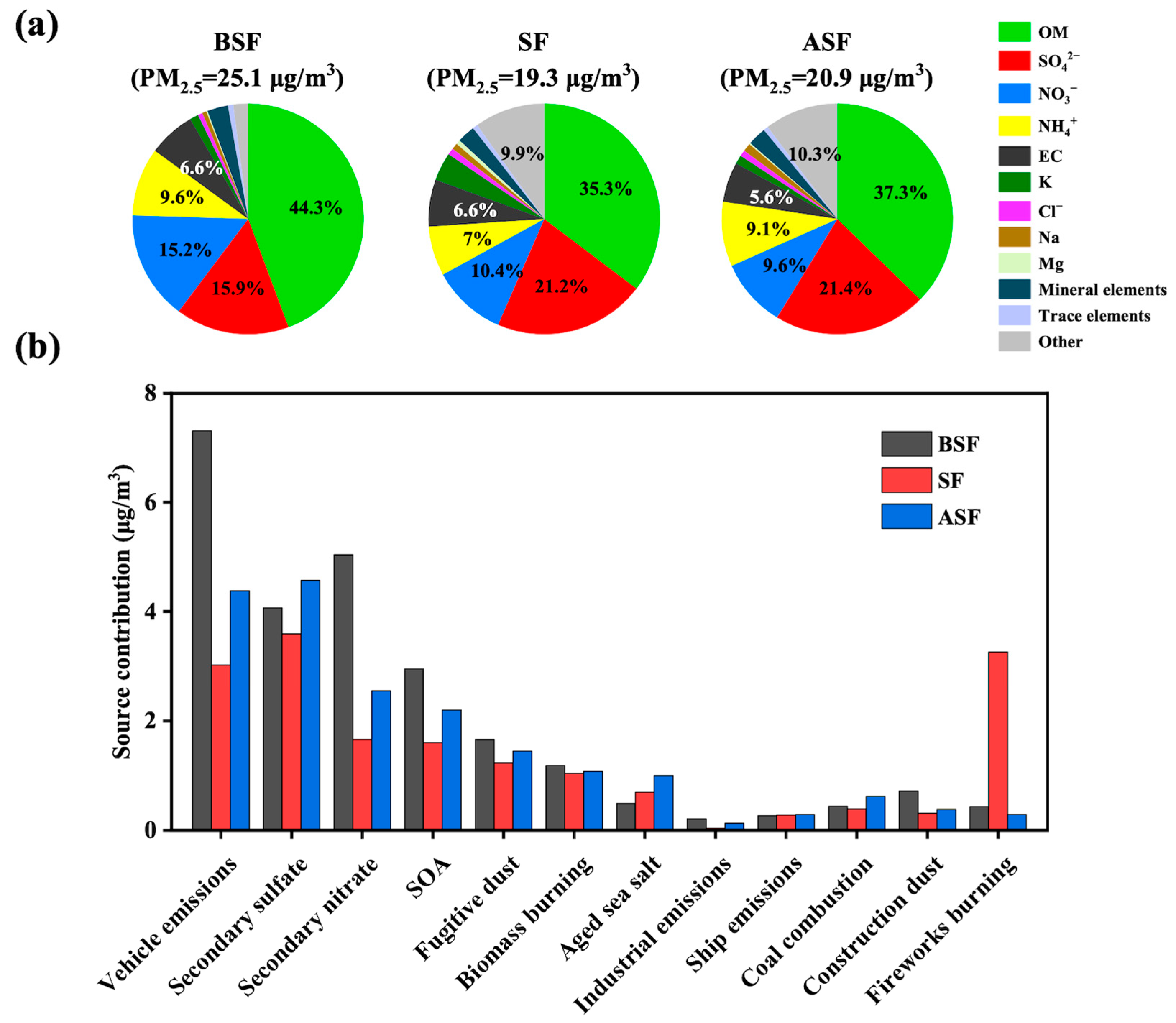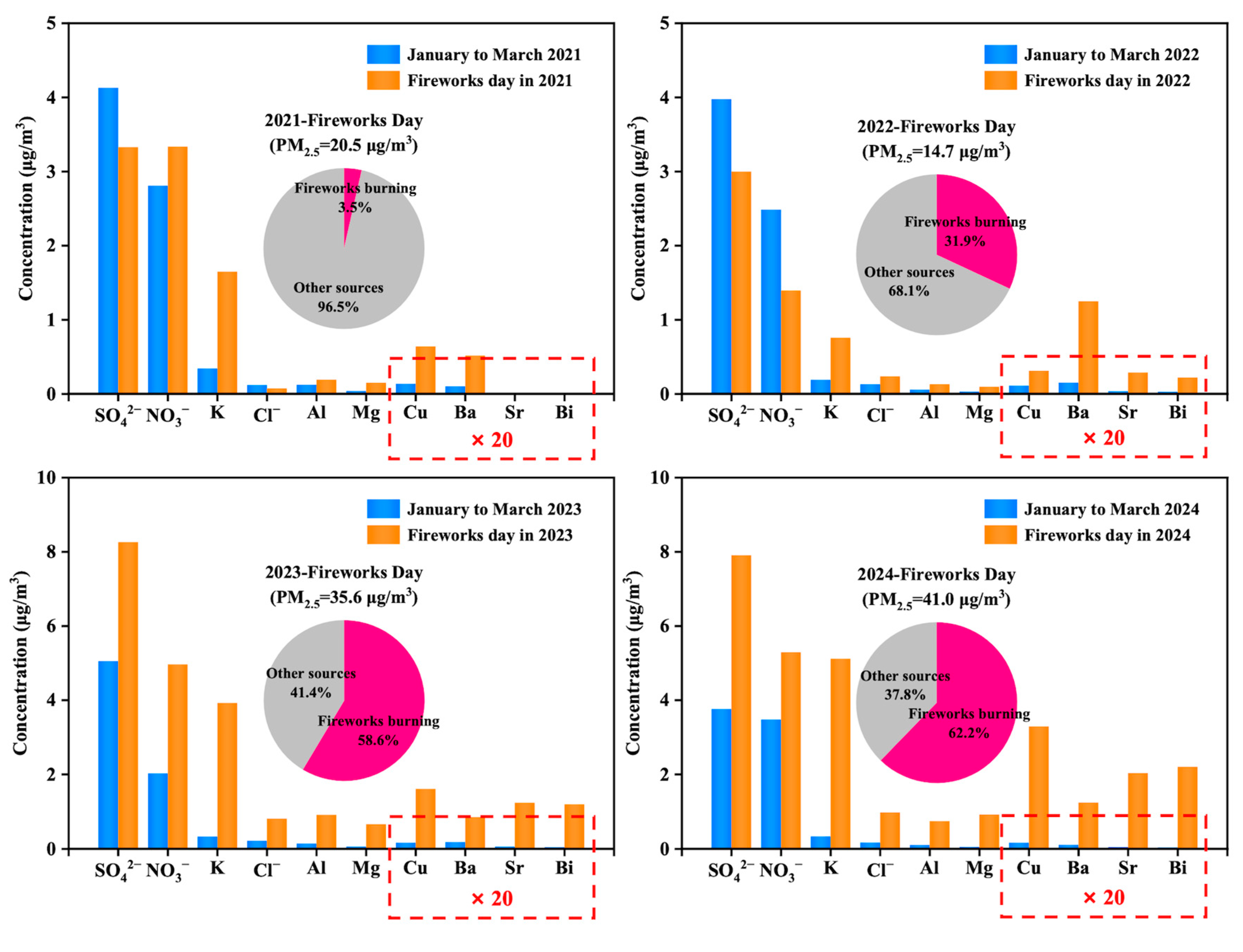Source Apportionment of PM2.5 in a Chinese Megacity During Special Periods: Unveiling Impacts of COVID-19 and Spring Festival
Abstract
1. Introduction
2. Materials and Methods
2.1. PM2.5 Sampling
2.2. Chemical Analysis
2.3. Positive Matrix Factorization (PMF) Model
3. Results and Discussion
3.1. Overview of PM2.5 and Its Components
3.2. PMF Source Apportionment
3.2.1. Identification of the PM2.5 Sources
3.2.2. Trends of PM2.5 Sources
3.3. The Impact of the Spring Festival on PM2.5
3.3.1. Changes in PM2.5 Compositions and Source Structure
3.3.2. Significant Impact of Fireworks Burning
4. Conclusions
Supplementary Materials
Author Contributions
Funding
Institutional Review Board Statement
Informed Consent Statement
Data Availability Statement
Acknowledgments
Conflicts of Interest
References
- An, Z.S.; Huang, R.J.; Zhang, R.Y.; Tie, X.X.; Li, G.H.; Cao, J.J.; Zhou, W.J.; Shi, Z.G.; Han, Y.M.; Gu, Z.L.; et al. Severe haze in northern China: A synergy of anthropogenic emissions and atmospheric processes. Proc. Natl. Acad. Sci. USA 2019, 116, 8657–8666. [Google Scholar] [CrossRef]
- Yu, W.H.; Xu, R.B.; Ye, T.T.; Abramson, M.J.; Morawska, L.; Jalaludin, B.; Johnston, F.H.; Henderson, S.B.; Knibbs, L.D.; Morgan, G.G.; et al. Estimates of global mortality burden associated with short-term exposure to fine particulate matter (PM2.5). Lancet Planet. Health 2024, 8, e146–e155. [Google Scholar] [CrossRef]
- Geng, G.N.; Liu, Y.X.; Liu, Y.; Liu, S.G.; Cheng, J.; Yan, L.; Wu, N.N.; Hu, H.W.; Tong, D.; Zheng, B.; et al. Efficacy of China’s clean air actions to tackle PM2.5 pollution between 2013 and 2020. Nat. Geosci. 2024, 17, 987–994. [Google Scholar] [CrossRef]
- Sun, H.T.; Shin, Y.M.; Xia, M.; Ke, S.; Wan, M.; Yuan, L.; Guo, Y.; Archibald, A.T. Spatial resolved surface ozone with urban and rural differentiation during 1990-2019: A Space-Time bayesian neural network downscaler. Environ. Sci. Technol. 2022, 56, 7337–7349. [Google Scholar] [CrossRef]
- Zhong, Q.R.; Tao, S.; Ma, J.M.; Liu, J.; Shen, H.Z.; Shen, G.F.; Guan, D.B.; Yun, X.; Meng, W.J.; Yu, X.Y.; et al. PM2.5 reductions in Chinese cities from 2013 to 2019 remain significant despite the inflating effects of meteorological conditions. One Earth 2021, 4, 448–458. [Google Scholar] [CrossRef]
- Chen, Z.Y.; Chen, D.L.; Zhao, C.F.; Kwan, M.P.; Cai, J.; Zhuang, Y.; Zhao, B.; Wang, X.Y.; Chen, B.; Yang, J.; et al. Influence of meteorological conditions on PM2.5 concentrations across China: A review of methodology and mechanism. Environ. Int. 2020, 139, 105558. [Google Scholar] [CrossRef] [PubMed]
- Huang, X.F.; Zou, B.B.; He, L.Y.; Hu, M.; Prévôt, A.S.; Zhang, Y.H. Exploration of PM2.5 sources on the regional scale in the Pearl River Delta based on ME-2 modeling. Atmos. Chem. Phys. 2018, 18, 11563–11580. [Google Scholar] [CrossRef]
- Yang, S.; Duan, F.K.; Ma, Y.L.; Li, H.; Ma, T.; Zhu, L.D.; Huang, T.; Kimoto, T.; He, K.B. Mixed and intensive haze pollution during the transition period between autumn and winter in Beijing, China. Sci. Total Environ. 2020, 711, 134745. [Google Scholar] [CrossRef] [PubMed]
- Hammer, M.S.; Van Donkelaar, A.; Martin, R.V.; Mcduffie, E.E.; Lyapustin, A.; Sayer, A.M.; Hsu, N.C.; Levy, R.C.; Garay, M.J.; Kalashnikova, O.V.; et al. Effects of COVID-19 lockdowns on fine particulate matter concentrations. Sci. Adv. 2021, 7, 7670. [Google Scholar] [CrossRef] [PubMed]
- Zheng, B.; Geng, G.N.; Ciais, P.; Davis, S.J.; Martin, R.V.; Meng, J.; Wu, N.N.; Chevallier, F.; Broquet, G.; Boersma, F.; et al. Satellite-based estimates of decline and rebound in China’s CO2 emissions during COVID-19 pandemic. Sci. Adv. 2020, 6, 4998. [Google Scholar] [CrossRef]
- Jiang, Q.; Sun, Y.L.; Wang, Z.; Yin, Y. Aerosol composition and sources during the Chinese Spring Festival: Fireworks, secondary aerosol, and holiday effects. Atmos. Chem. Phys. 2015, 15, 6023–6034. [Google Scholar] [CrossRef]
- Wang, C.; Huang, X.F.; Zhu, Q.; Cao, L.M.; Zhang, B.; He, L.Y. Differentiating local and regional sources of Chinese urban air pollution based on the effect of the Spring Festival. Atmos. Chem. Phys. 2017, 17, 9103–9114. [Google Scholar] [CrossRef]
- Tian, M.; Liu, Y.; Yang, F.M.; Zhang, L.M.; Peng, C.; Chen, Y.; Shi, G.M.; Wang, H.B.; Luo, B.; Jiang, C.T.; et al. Increasing importance of nitrate formation for heavy aerosol pollution in two megacities in Sichuan Basin, southwest China. Environ. Pollut. 2019, 250, 898–905. [Google Scholar] [CrossRef]
- Kroll, J.H.; Heald, C.L.; Cappa, C.D.; Farmer, D.K.; Fry, J.L.; Murphy, J.G.; Steiner, A.L. The complex chemical effects of COVID-19 shutdowns on air quality. Nat. Chem. 2020, 12, 777–779. [Google Scholar] [CrossRef]
- Silver, B.; He, X.Y.; Arnold, S.R.; Spracklen, D.V. The impact of COVID-19 control measures on air quality in China. Environ. Res. Lett. 2020, 15, 084021. [Google Scholar] [CrossRef]
- Baldasano, J.M. COVID-19 lockdown effects on air quality by NO2 in the cities of Barcelona and Madrid (Spain). Sci. Total Environ. 2020, 741, 140353. [Google Scholar] [CrossRef] [PubMed]
- Shi, G.L.; Liu, G.R.; Tian, Y.Z.; Zhou, X.Y.; Peng, X.; Feng, Y.C. Chemical characteristic and toxicity assessment of particle associated PAHs for the short-term anthropogenic activity event: During the Chinese New Year’s Festival in 2013. Sci. Total Environ. 2014, 482, 8–14. [Google Scholar] [CrossRef]
- Feng, J.; Sun, P.; Hu, X.; Zhao, W.; Wu, M.; Fu, J. The chemical composition and sources of PM2.5 during the 2009 Chinese New Year’s holiday in Shanghai. Atmos. Res. 2012, 118, 435–444. [Google Scholar] [CrossRef]
- Kumar, M.; Singh, R.K.; Murari, V.; Singh, A.K.; Singh, R.S.; Banerjee, T. Fireworks induced particle pollution: A spatio-temporal analysis. Atmos. Res. 2016, 180, 78–91. [Google Scholar] [CrossRef]
- Huang, K.; Zhuang, G.; Lin, Y.; Wang, Q.; Fu, J.; Zhang, R.; Li, J.; Deng, C.; Fu, Q. Impact of anthropogenic emission on air quality over a megacity − revealed from an intensive atmospheric campaign during the Chinese Spring Festival. Atmos. Chem. Phys. 2012, 12, 11631–11645. [Google Scholar] [CrossRef]
- Shi, J.W.; Deng, L.; Du, W.; Han, X.Y.; Zhong, Y.Q.; Rao, W.J.; Xie, H.T.; Xiang, F.; Ning, P.; Tian, S.L. Chemical characteristics, sources, and formation mechanisms of PM2.5 before, during, and after the Spring Festival in a plateau city of Southwest China. Atmos. Environ. 2024, 338, 120788. [Google Scholar] [CrossRef]
- Song, L.L.; Dai, Q.L.; Feng, Y.C.; Hopke, P.K. Estimating uncertainties of source contributions to PM2.5 using moving window evolving dispersion normalized PMF. Environ. Pollut. 2021, 286, 117576. [Google Scholar] [CrossRef]
- Zhang, Y.J.; Li, W.S.; Li, L.; Li, M.; Zhou, Z.; Yu, J.Z.; Zhou, Y. Source apportionment of PM2.5 using PMF combined online bulk and single-particle measurements: Contribution of fireworks and biomass burning. J. Environ. Sci. 2024, 136, 325–336. [Google Scholar] [CrossRef]
- Bach, W.; Dickinson, L.; Weiner, B.; Costello, G. Some adverse health effects due to air pollution from fireworks. Hawaii Med. J. 1972, 31, 459–465. [Google Scholar]
- Godri, K.J.; Green, D.C.; Fuller, G.W.; Dall’osto, M.; Beddows, D.C.; Kelly, F.J.; Harrison, R.M.; Mudway, I.S. Particulate oxidative burden associated with firework activity. Environ. Sci. Technol. 2010, 44, 8295–8301. [Google Scholar] [CrossRef]
- Kong, S.F.; Li, X.; Li, L.; Yin, Y.; Chen, K.; Yuan, L.; Zhang, Y.J.; Shan, Y.P.; Ji, Y.Q. Variation of polycyclic aromatic hydrocarbons in atmospheric PM2.5 during winter haze period around 2014 Chinese Spring Festival at Nanjing: Insights of source changes, air mass direction and firework particle injection. Sci. Total Environ. 2015, 520, 59–72. [Google Scholar] [CrossRef]
- Pang, N.N.; Jiang, B.Y.; Zheng, Y.H. The impact of fireworks burning on air quality and their health effects in China during Spring Festivals of 2015–2022. Atmos. Pollut. Res. 2023, 14, 101888. [Google Scholar] [CrossRef]
- Lai, Y.H.; Brimblecombe, P. Changes in air pollution and attitude to fireworks in Beijing. Atmos. Environ. 2020, 231, 117549. [Google Scholar] [CrossRef]
- Zheng, H.; Kong, S.F.; Chen, N.; Yan, Y.Y.; Liu, D.T.; Zhu, B.; Xu, K.; Cao, W.X.; Ding, Q.Q.; Lan, B.; et al. Significant changes in the chemical compositions and sources of PM2.5 Wuhan since the city lockdown as COVID-19. Sci. Total Environ. 2020, 739, 140000. [Google Scholar] [CrossRef] [PubMed]
- Tang, M.X.; Huang, X.F.; Sun, T.L.; Cheng, Y.; Luo, Y.; Chen, Z.; Lin, X.Y.; Cao, L.M.; Zhai, Y.H.; He, L.Y. Decisive role of ozone formation control in winter PM2.5 mitigation in Shenzhen, China. Environ. Pollut. 2022, 301, 119027. [Google Scholar] [CrossRef] [PubMed]
- Peng, X.; Xie, T.T.; Tang, M.X.; Cheng, Y.; Peng, Y.; Wei, F.H.; Cao, L.M.; Yu, K.Y.; Du, K.; He, L.Y.; et al. Critical Role of Secondary Organic Aerosol in Urban Atmospheric Visibility Improvement Identified by Machine Learning. Environ. Sci. Technol. Lett. 2023, 10, 976–982. [Google Scholar] [CrossRef]
- Paatero, P.; Tapper, U. Positive matrix factorization: A nonnegative factor model with optimal utilization of error-estimates of data values. Environmetrics 1994, 5, 111–126. [Google Scholar] [CrossRef]
- Su, C.P.; Peng, X.; Huang, X.F.; Zeng, L.W.; Cao, L.M.; Tang, M.X.; Chen, Y.; Zhu, B.; Wang, Y.S.; He, L.Y. Development and application of a mass closure PM2.5 composition online monitoring system. Atmos. Meas. Tech. 2020, 13, 5407–5422. [Google Scholar] [CrossRef]
- Zheng, L.X.; Wu, D.; Chen, X.; Li, Y.; Cheng, A.U.; Yi, J.U.; Li, Q. Chemical profiles of particulate matter emitted from anthropogenic sources in selected regions of China. Sci. Data 2024, 11, 1206. [Google Scholar] [CrossRef] [PubMed]
- Du, B.H.; Huang, X.F.; He, L.Y.; Hu, M.; Wang, C.; Ren, Y.C.; Ying, H.M.; Zhou, J.; Wang, W.F.; Xu, D.D. Seasonal and spatial variations of carbon fractions in PM2.5 in Ningbo and the estimation of secondary organic carbon. Environ. Sci. 2015, 36, 3128–3134. [Google Scholar]
- Sun, T.L.; Zou, B.B.; Huang, X.F.; Shen, H.Y.; Dai, J.; He, L.Y. Source apportionment of PM2.5 pollution in Shenzhen. China Environ. Sci. 2019, 39, 13–20. [Google Scholar]
- Van Bohemen, H.D.; Van De Laak, W.H.J. The influence of road infrastructure and traffic on soil, water, and air quality. Environ. Manag. 2003, 31, 50–68. [Google Scholar] [CrossRef] [PubMed]
- Yuan, Z.B.; Lau, A.; Zhang, H.Y.; Yu, J.; Louie, P.; Fung, J. Identification and spatiotemporal variations of dominant PM10 sources over Hong Kong. Atmos. Environ. 2006, 40, 1803–1815. [Google Scholar] [CrossRef]
- He, L.Y.; Huang, X.F.; Xue, L.; Hu, M.; Lin, Y.; Zheng, J.; Zhang, R.Y.; Zhang, Y.H. Submicron aerosol analysis and organic source apportionment in an urban atmosphere in Pearl River Delta of China using high-resolution aerosol mass spectrometry. J. Geophys. Res.-Atmos. 2011, 116, D12304. [Google Scholar] [CrossRef]
- Jimenez, J.L.; Canagaratna, M.R.; Donahue, N.M.; Prevot, A.S.H.; Zhang, Q.; Kroll, J.H.; Decarlo, P.F.; Allan, J.D.; Coe, H.; Ng, N.L.; et al. Evolution of organic aerosols in the atmosphere. Science 2009, 326, 1525–1529. [Google Scholar] [CrossRef]
- Link, M.F.; Kim, J.; Park, G.; Lee, T.; Park, T.; Babar, Z.B.; Sung, K.; Kim, P.; Kang, S.; Kim, J.S.; et al. Elevated production of NH4NO3 from the photochemical processing of vehicle exhaust: Implications for air quality in the Seoul Metropolitan Region. Atmos. Environ. 2017, 156, 95–101. [Google Scholar] [CrossRef]
- Ge, X.L.; Li, L.; Chen, Y.F.; Chen, H.; Wu, D.; Wang, J.F.; Xie, X.C.; Ge, S.; Ye, Z.L.; Xu, J.Z.; et al. Aerosol characteristics and sources in Yangzhou, China resolved by offline aerosol mass spectrometry and other techniques. Environ. Pollut. 2017, 225, 74–85. [Google Scholar] [CrossRef]
- Yamasoe, M.A.; Artaxo, P.; Miguel, A.H.; Allen, A.G. Chemical composition of aerosol particles from direct emissions of vegetation fires in the Amazon Basin: Water-soluble species and trace elements. Atmos. Environ. 2000, 34, 1641–1653. [Google Scholar] [CrossRef]
- Hasheminassab, S.; Daher, N.; Saffari, A.; Wang, D.; Ostro, B.D.; Sioutas, C. Spatial and temporal variability of sources of ambient fine particulate matter (PM2.5) in California. Atmos. Chem. Phys. 2014, 14, 12085–12097. [Google Scholar] [CrossRef]
- Stanimirova, I.; Rich, D.Q.; Russell, A.G.; Hopke, P.K. Common and distinct pollution sources identified from ambient PM2.5 concentrations in two sites of Los Angeles Basin from 2005 to 2019. Environ. Pollut. 2024, 340, 122817. [Google Scholar] [CrossRef]
- Zhu, Q.; Liu, Y.; Hasheminassab, S. Long-term source apportionment of PM2.5 across the contiguous United States (2000-2019) using a multilinear engine model. J. Hazard. Mater. 2024, 472, 134550. [Google Scholar] [CrossRef]
- Yassine, M.M.; Dabek-Zlotorzynska, E.; Celo, V.; Sofowote, U.M.; Mooibroek, D.; Hopke, P.K. Effect of industrialization on the differences in sources and composition of ambient PM2.5 in two Southern Ontario locations. Environ. Pollut. 2024, 341, 123007. [Google Scholar] [CrossRef]
- Jain, S.; Sharma, S.K.; Vijayan, N.; Mandal, T.K. Seasonal characteristics of aerosols (PM2.5 and PM10) and their source apportionment using PMF: A four year study over Delhi, India. Environ. Pollut. 2020, 262, 114337. [Google Scholar] [CrossRef] [PubMed]
- Chow, J.C.; Watson, J.G. Review of PM2.5 and PM10 apportionment for fossil fuel combustion and other sources by the chemical mass balance receptor model. Energy Fuels 2002, 16, 222–260. [Google Scholar] [CrossRef]
- Lan, Z.J.; Jiang, J.H.; Lin, L.L.; Huang, X.F.; He, L.Y. Source analysis of PM2.5 in the typical mixed functional zone of Shenzhen. China Environ. Sci. 2021, 41, 4001–4008. [Google Scholar]
- Zhang, G.Q.; Ding, C.; Jiang, X.J.; Pan, G.; Wei, X.F.; Sun, Y.M. Chemical compositions and sources contribution of atmospheric particles at a typical steel industrial urban site. Sci. Rep. 2020, 10, 7654. [Google Scholar] [CrossRef]
- Shen, Z.X.; Sun, J.; Cao, J.J.; Zhang, L.M.; Zhang, Q.; Lei, Y.L.; Gao, J.J.; Huang, R.J.; Liu, S.X.; Huang, Y.; et al. Chemical profiles of urban fugitive dust PM2.5 samples in Northern Chinese cities. Sci. Total Environ. 2016, 569, 619–626. [Google Scholar] [CrossRef]
- Wang, W.H.; Zhou, H.; Gao, Y.T.; Shao, L.Y.; Zhou, X.Y.; Li, X.; Wei, D.Q.; Xing, J.P.; Lyu, R.H. Chemical composition and morphology of PM2.5 in a rural valley during Chinese New Year’s Eve: Impact of firework/firecracker display. Atmos. Environ. 2024, 318, 120225. [Google Scholar] [CrossRef]
- Wang, S.S.; Yu, R.L.; Shen, H.Z.; Wang, S.; Hu, Q.C.; Cui, J.Y.; Yan, Y.; Huang, H.B.; Hu, G.R. Chemical characteristics, sources, and formation mechanisms of PM2.5 before and during the Spring Festival in a coastal city in Southeast China. Environ. Pollut. 2019, 251, 442–452. [Google Scholar] [CrossRef]
- Lanz, V.A.; Alfarra, M.R.; Baltensperger, U.; Buchmann, B.; Hueglin, C.; Prevot, A.S.H. Source apportionment of submicron organic aerosols at an urban site by factor analytical modelling of aerosol mass spectra. Atmos. Chem. Phys. 2007, 7, 1503–1522. [Google Scholar] [CrossRef]
- Wu, K.Y.; Duan, M.; Liu, H.F.; Zhou, Z.H.; Deng, Y.; Song, D.L.; Tan, Q. Characterizing the composition and evolution of firework-related components in air aerosols during the Spring Festival. Environ. Geochem. Health 2018, 40, 2761–2771. [Google Scholar] [CrossRef] [PubMed]
- Lv, W.L.; Zhang, K.; Cao, Q.; Zhu, S.; Chen, J.H.; Zhi, M.K.; Li, D. Impacts of fireworks burning on atmospheric pollutants and water-soluble inorganic ions in PM2.5. China Environ. Sci. 2020, 40, 3303–3311. [Google Scholar]
- Tsai, H.H.; Chien, L.H.; Yuan, C.S.; Lin, Y.C.; Jen, Y.H.; Ie, I.R. Influences of fireworks on chemical characteristics of atmospheric fine and coarse particles during Taiwan’s Lantern Festival. Atmos. Environ. 2012, 62, 256–264. [Google Scholar] [CrossRef]
- Keller, F.; Schragen, C. Determination of particulate matter emission factors of common pyrotechnic articles. Propellants Explos. Pyrotech. 2021, 46, 825–842. [Google Scholar] [CrossRef]
- Khedr, M.; Liu, X.; Hadiatullah, H.; Orasche, J.; Zhang, X.; Cyrys, J.; Michalke, B.; Zimmermann, R.; Schnelle-Kreis, J. Influence of New Year’s fireworks on air quality − A case study from 2010 to 2021 in Augsburg, Germany. Atmos. Pollut. Res. 2022, 13, 101341. [Google Scholar] [CrossRef]
- Srinivasan, K. Eco-friendly fireworks for atom bomb (Local name of cracker bomb). J. Adv. Appl. Sci. Res. 2017, 1. [Google Scholar] [CrossRef]





Disclaimer/Publisher’s Note: The statements, opinions and data contained in all publications are solely those of the individual author(s) and contributor(s) and not of MDPI and/or the editor(s). MDPI and/or the editor(s) disclaim responsibility for any injury to people or property resulting from any ideas, methods, instructions or products referred to in the content. |
© 2025 by the authors. Licensee MDPI, Basel, Switzerland. This article is an open access article distributed under the terms and conditions of the Creative Commons Attribution (CC BY) license (https://creativecommons.org/licenses/by/4.0/).
Share and Cite
Tang, K.; Peng, X.; Liu, Y.; Liu, S.; Tang, S.; Wu, J.; Wang, S.; Xie, T.; Yao, T. Source Apportionment of PM2.5 in a Chinese Megacity During Special Periods: Unveiling Impacts of COVID-19 and Spring Festival. Atmosphere 2025, 16, 908. https://doi.org/10.3390/atmos16080908
Tang K, Peng X, Liu Y, Liu S, Tang S, Wu J, Wang S, Xie T, Yao T. Source Apportionment of PM2.5 in a Chinese Megacity During Special Periods: Unveiling Impacts of COVID-19 and Spring Festival. Atmosphere. 2025; 16(8):908. https://doi.org/10.3390/atmos16080908
Chicago/Turabian StyleTang, Kejin, Xing Peng, Yuqi Liu, Sizhe Liu, Shihai Tang, Jiang Wu, Shaoxia Wang, Tingting Xie, and Tingting Yao. 2025. "Source Apportionment of PM2.5 in a Chinese Megacity During Special Periods: Unveiling Impacts of COVID-19 and Spring Festival" Atmosphere 16, no. 8: 908. https://doi.org/10.3390/atmos16080908
APA StyleTang, K., Peng, X., Liu, Y., Liu, S., Tang, S., Wu, J., Wang, S., Xie, T., & Yao, T. (2025). Source Apportionment of PM2.5 in a Chinese Megacity During Special Periods: Unveiling Impacts of COVID-19 and Spring Festival. Atmosphere, 16(8), 908. https://doi.org/10.3390/atmos16080908




